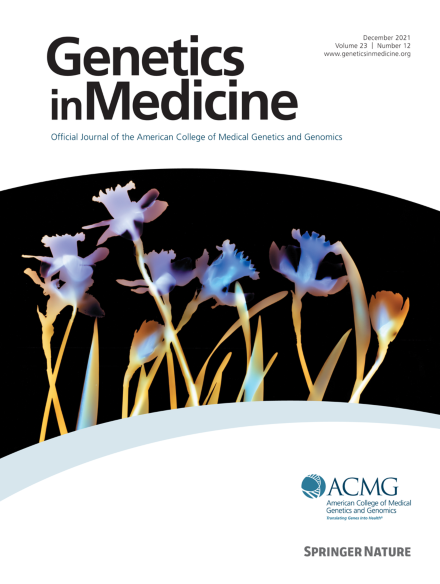英国癌症变异解释小组(CanVIG-UK)为遗传学临床医生和临床科学家提供的框架:英国癌症变异解释小组(CanVIG-UK)的《遗传学临床医师和临床科学家框架》。
IF 6.6
1区 医学
Q1 GENETICS & HEREDITY
引用次数: 0
摘要
目的:尽管有越来越多的证据表明风险关联中的变异体之间存在差异,但目前的做法是将特定癌症易感基因(CSG)中可能的致病/致病变异体当作具有同等穿透力的变异体进行报告和管理。使用现有的变异解释方法(主要基于全穿透模型),怀疑穿透性降低的变异可能会被不一致地归类和/或归类为意义不确定的变异(VUS)。我们的目标是在英国癌症变异解释小组(CanVIG-UK)多学科网络内为此类变异制定一种全国共识方法:方法:在英国癌症变异解释小组(CanVIG-UK)月度会议期间和会议间隙,针对可能表明穿透性降低的各种情况进行了一系列调查和现场投票。结果:CanVIG-UK 指导和顾问小组 (CStAG) 工作组在反复制定穿透性降低变异体分类框架时参考了这些信息:结果:CanVIG-UK 建议对 2015 年 ACMG/AMP 变异解释框架进行修订,该框架适用于以下变异:(A) 有确凿证据表明渗透率效应大小降低(如病例对照或分离数据);(B) 从较弱/可能不一致的观察数据中推断出渗透率效应降低:CanVIG-UK 提出了一个框架,用于对高渗透性基因中渗透性降低的变异进行分类。这些原则虽然是针对 CSGs 制定的,但有可能适用于其他临床情况。本文章由计算机程序翻译,如有差异,请以英文原文为准。
Classification of variants of reduced penetrance in high-penetrance cancer susceptibility genes: Framework for genetics clinicians and clinical scientists by CanVIG-UK (Cancer Variant Interpretation Group-UK)
Purpose
Current practice is to report and manage likely pathogenic/pathogenic variants in a given cancer susceptibility gene as though having equivalent penetrance, despite increasing evidence of intervariant variability in risk associations. Using existing variant interpretation approaches, largely based on full-penetrance models, variants in which reduced penetrance is suspected may be classified inconsistently and/or as variants of uncertain significance. We aimed to develop a national consensus approach for such variants within the Cancer Variant Interpretation Group UK (CanVIG-UK) multidisciplinary network.
Methods
A series of surveys and live polls were conducted during and between CanVIG-UK monthly meetings on various scenarios potentially indicating reduced penetrance. These informed the iterative development of a framework for the classification of variants of reduced penetrance by the CanVIG-UK Steering and Advisory Group working group.
Results
CanVIG-UK recommendations for amendment of the 2015 ACMG/AMP variant interpretation framework were developed for variants in which (A) active evidence suggests a reduced-penetrance effect size (eg, from case-control or segregation data) and (B) reduced penetrance effect is inferred from weaker/potentially inconsistent observed data.
Conclusion
CanVIG-UK propose a framework for the classification of variants of reduced penetrance in high-penetrance genes. These principles, although developed for cancer susceptibility genes, are potentially applicable to other clinical contexts.
求助全文
通过发布文献求助,成功后即可免费获取论文全文。
去求助
来源期刊

Genetics in Medicine
医学-遗传学
CiteScore
15.20
自引率
6.80%
发文量
857
审稿时长
1.3 weeks
期刊介绍:
Genetics in Medicine (GIM) is the official journal of the American College of Medical Genetics and Genomics. The journal''s mission is to enhance the knowledge, understanding, and practice of medical genetics and genomics through publications in clinical and laboratory genetics and genomics, including ethical, legal, and social issues as well as public health.
GIM encourages research that combats racism, includes diverse populations and is written by authors from diverse and underrepresented backgrounds.
 求助内容:
求助内容: 应助结果提醒方式:
应助结果提醒方式:


